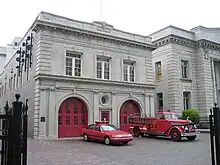Adams Avenue Historic District | |
 Memphis Police Station, 128 Adams Avenue | |
  | |
| Location | Adams and Washington Aves., Memphis, Tennessee |
|---|---|
| Coordinates | 35°08′54″N 90°02′59″W / 35.148333°N 90.049722°W |
| Area | 9 acres (3.6 ha) |
| Architect | Multiple |
| Architectural style | Classical Revival, Late Gothic Revival |
| NRHP reference No. | 80004481[1] |
| Added to NRHP | November 25, 1980 |
The Adams Avenue Historic District in Memphis, Tennessee is a 9 acres (3.6 ha) historic district which was listed on the National Register of Historic Places in 1980.[1]
It contains six contributing buildings:
- St. Peter's Roman Catholic Church (1852), at 190 Adams Ave.
- North Memphis Savings Bank (1901), at 110 Adams Ave.
- Shelby County Courthouse (1909), at 160 Adams Ave., which was designed by architects H. D. Hale and James Gamble Rogers, who both were students of the Ecole de Beaux Arts in Paris. It has sculpture groups in its four pediments, designed by J. Massey Rhind.
- Fire Engine House No. 1 (1910), at 118 Adams Ave.
- Memphis Police Station (1911), at 128 or 130 Adams Ave.
- Criminal Courts Building (1925), at 156 Washington Ave.[2]
 Fire Engine House No. 1
Fire Engine House No. 1 Shelby County Courthouse
Shelby County Courthouse
History
Nathan Bedford Forrest reportedly operated a slave market in this district, said to be the South’s largest at the time.[3]
References
- 1 2 "National Register Information System". National Register of Historic Places. National Park Service. July 9, 2010.
- ↑ Herbert L. Harper (January 1980). "National Register of Historic Places Inventory/Nomination: Adams Avenue Historic District". National Park Service. Retrieved May 17, 2017. With eight photos from 1979.
- ↑ Hampton Sides, 2011, Hellhound on His Trail, p.14
This article is issued from Wikipedia. The text is licensed under Creative Commons - Attribution - Sharealike. Additional terms may apply for the media files.